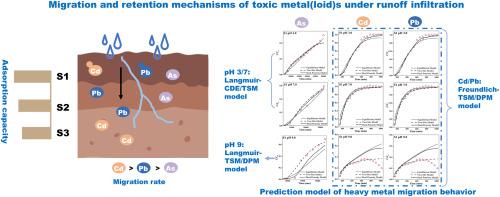耦合实验和建模方法揭示砷,镉和铅在铅锌冶炼厂周围土壤中的离子特异性迁移行为
IF 7.3
2区 环境科学与生态学
Q1 ENVIRONMENTAL SCIENCES
引用次数: 0
摘要
径流入渗过程中砷(As)、镉(Cd)和铅(Pb)在铅锌(Pb- zn)冶炼污染土壤中的动态迁移机制尚不清楚。采用间歇式吸附和动态柱实验研究了As、Cd和Pb在典型铅锌矿区酸性红壤中的迁移行为。结果表明,表层土壤的吸附能力明显高于深层土壤。As(V)优先以单层结构结合在表面聚集体上,而Cd(II)和Pb(II)通过更复杂的多层结构粘附在表面。表层(S1)的Ks和D值较低,表明其截留污染物的能力强于中间层(S2)和深层(S3)。柱实验建立了酸性土壤中Cd(II) > Pb(II) > As(V)的迁移率递减顺序。在pH高于6.5时,土壤吸附位点的去质子化增强了Cd2+和Pb2+对Cd(OH)2和Pb(OH)2的吸附和络合作用,但同时增强了对HAsO42-、HAsO3-和AsO43-的静电斥力。结合等温吸附和非平衡模型有效地捕获了As, Cd和Pb离子的迁移趋势,尽管Pb的中期迁移滞后降低了预测精度。酸性土壤的化学和矿物特征有助于预测As(Ⅴ)的滞留,而Cd(II)和Pb(II)的滞留因子(Rf)与土壤矿物学关系更密切,特别是铁氧化物含量和形态。这些发现为研究有毒金属在污染土壤中的迁移控制机制提供了有价值的见解,这对于制定有效的冶炼厂影响地区污染土壤修复策略至关重要。本文章由计算机程序翻译,如有差异,请以英文原文为准。

Coupled experimental and modeling approaches to reveal ion-specific migration behavior of arsenic, cadmium, and lead in soils surrounding Pb–Zn smelters
The dynamic migration mechanisms of arsenic (As), cadmium (Cd), and lead (Pb) in soils contaminated by lead-zinc (Pb-Zn) smelting during runoff infiltration remain poorly understood. This study employed batch adsorption and dynamic column experiments to investigate the migration behavior of As, Cd and Pb in acidic red soils around typical Pb-Zn mining regions. Results demonstrated that surface soils exhibited significantly higher adsorption capacities than deeper layers. As(V) preferentially bound to surface aggregates in a monolayer configuration, while Cd(II) and Pb(II) adhered through a more complex, multilayered arrangement. The surface layer (S1) had lower Ks and D value, indicating a stronger pollutant retention capacity than the intermediate (S2) and deep (S3) layers. Column experiments established a descending mobility order of Cd(II) > Pb(II) > As(V) in acidic soils. At pH levels above 6.5, the deprotonation of soil adsorption sites enhanced Cd2+ and Pb2+ adsorption and complexation with Cd(OH)2 and Pb(OH)2, but simultaneously increased electrostatic repulsion against HAsO42−, HAsO3−, and AsO43−. A combined isothermal adsorption and non-equilibrium model effectively captured the migration trends of As, Cd, and Pb ions, though mid-migration hysteresis of Pb reduced predictive accuracy. Acidic soil chemical and mineral characteristics were instrumental in predicting As(Ⅴ) retention, whereas the retardation factors (Rf) for Cd(II) and Pb(II) were more closely associated with soil mineralogy, particularly Fe oxide content and speciation. These findings provide valuable insights into the controlling mechanisms of toxic metal migration in contaminated soils, which is crucial for developing effective remediation strategies for polluted soils in areas impacted by smelter.
求助全文
通过发布文献求助,成功后即可免费获取论文全文。
去求助
来源期刊

Environmental Pollution
环境科学-环境科学
CiteScore
16.00
自引率
6.70%
发文量
2082
审稿时长
2.9 months
期刊介绍:
Environmental Pollution is an international peer-reviewed journal that publishes high-quality research papers and review articles covering all aspects of environmental pollution and its impacts on ecosystems and human health.
Subject areas include, but are not limited to:
• Sources and occurrences of pollutants that are clearly defined and measured in environmental compartments, food and food-related items, and human bodies;
• Interlinks between contaminant exposure and biological, ecological, and human health effects, including those of climate change;
• Contaminants of emerging concerns (including but not limited to antibiotic resistant microorganisms or genes, microplastics/nanoplastics, electronic wastes, light, and noise) and/or their biological, ecological, or human health effects;
• Laboratory and field studies on the remediation/mitigation of environmental pollution via new techniques and with clear links to biological, ecological, or human health effects;
• Modeling of pollution processes, patterns, or trends that is of clear environmental and/or human health interest;
• New techniques that measure and examine environmental occurrences, transport, behavior, and effects of pollutants within the environment or the laboratory, provided that they can be clearly used to address problems within regional or global environmental compartments.
 求助内容:
求助内容: 应助结果提醒方式:
应助结果提醒方式:


